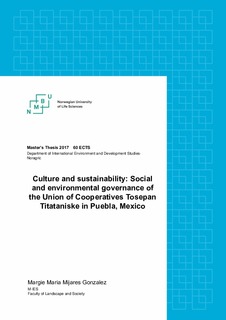| dc.description.abstract | This case study explored how the culture of the political actors of the Union of Cooperatives Tosepan Titataniske (Tosepan) in the region of the Northeastern Mountains of Puebla, Mexico, influence their social and environmental governance. Besides, it also assessed the strengths and the limits of such cultural influence to support the sustainability of the organization.
This study applied a qualitative research approach in order to answer the research questions based on the analysis of the collected data from the political ecology and environmental theoretical approaches.
The findings of this research indicated that there is a clear influence from 4 cultural features on Tosepan governance: 1. Identity, 2. Cooperation in community based interaction, 3. Indigenous political systems and 3. Their particular vision of nature. Moreover, the influence from these features has several impacts on the sustainability of the organization.
The political actors’ identity with the indigenous movement defines Tosepan goals and explains the permanence of the organization. However, there was not enough data to state its limits on sustainability. Cooperation in community based interaction influence diverse social, political, economic and environmental actions of Tosepan governance in a positive way, and it is the most useful cultural resource to support sustainability. Nevertheless, it encounters fundamental limits in the wider political and economic contexts, which determines the preferences of most of the organization’s economic actors (the producers), and this hinders the outcomes of the most important agricultural management programs of Tosepan. Further, the traditional indigenous political system is formally incorporated into Tosepan governance at all levels, it is efficient and democratic, but at the local level of 9 municipalities. It has a limit to growth or expansion with the same level of efficiency into the entire region of 28 municipalities. Finally, the vision of nature of the political actors comes from diverse influences that they have incorporated into a perspective that strengthens biodiversity and conservation. Nevertheless, the dominant economic visions of nature from the local to the global level hinders the intensification of a sustainable agriculture in all producers. Moreover, it represents an uneven force that is currently threatening not only Tosepan’s sustainability, but also the entire population and the environment of this Mexican region. | nb_NO |

